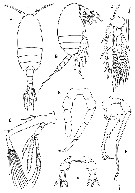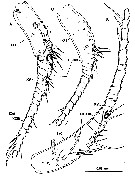|
|
 |
|
Calanoida ( Ordre ) |
|
|
|
Clausocalanoidea ( Superfamille ) |
|
|
| |
| | | |
| Pseudocyclopiidae T. Scott,1894 ; emend. Jaume, Fosshagen & Iliffe, 1999 ( Clausocalanoidea ) | | Ref.: | T. Scott, 1894 d (p.235); I.C. Thompson, 1895 (p. 99); Sars, 1902 (1903) (p.69); Gurney, 1931 a (p.85); Rose, 1933 a (p.166); Bradford, 1969 b (p.502, Table 3); Andronov, 1974 a (p.1005, 1008); Bowman & Abele, 1982 (p.9); Razouls, 1982 (p.394);1993 (p.310); Fosshagen & Iliffe, 1985 (p.350, Rev.); Huys & Boxshall, 1991 (p.337, 419); Bradford-Grieve, 1994 (p.131, Def.); Chihara & Murano, 1997 (p.892); Jaume & al., 1999 (p.392,405); Ohtsuka & Huys, 2001 (p.461); Boxshall & Halsey, 2004 (p.15; 49; 169: Def.; p.170: Genera Key); Vives & Shmeleva, 2007 (p.709, Genera key); Bradford-Grieve & al., 2014 (p.507, 526, Rem.)
Bradford-Grieve J.M., (2002 onwards). Key to calanoid copepod families. Version 1 : 2 oct 2002. http://www.crustacea.net/crustace/calanoida/index.htm  | | Rem.: | 4 G.: Paracyclopia, Pseudocyclopia, Stygocyclopia , Thompsonopia, + ? 1G: Frigocalanus (pour Boxshall & Halsey (2004) ce genre doit être inclus dans cette famille). |  issued from : E.L. Markhaseva & F.D. Ferrari in Invert. Zool., 2005, 2 (2). [p.162, Table 4] Setation of oral parts in females Pseudocyclopiidae (Clausocalanoidea) and ancestral condition of setation. |
 Issued from : G.A. Boxshall & S.H. Halsey in An Introduction to Copepod Diversity. The Ray Society, 2004, No 166, Part. I. [p.169]. Armature formula of swimming legs P1 to P4. Nota: Setation sometimes reduced; endopod of P1 with only 4 setae in Paracyclopia. 1st exopodal segment of P3 occasionally reported with 2 outer margin spines. Inner seta on coxa of P3 wery well developed, ofthen longer than endopod. - Female P5 uniramous, reduced; coimprising 2-segmenred protopod and 1-segmented exopod. Coxae fused to intercoxal sclerite. Exopod produced into 1 or 2 spines or spinous processes at tip and armed with 1 or 2 outer margin spines. - Male P5 asymmetrical; both legs typically comprising coxa, fused to intercoxal sclerite, basis and 1 to3-segmented exopod; right leg usually slender and with elongate distal segment, unarmed or with terminal and outer spines (in Paracyclopia); left leg swollen proximally in Pseudocyclopia; distal segments slender, armed with spiniform elements terminally.
- Eggs presumably released into water. |
 Issued from : G.A. Boxshall & S.H. Halsey in An Introduction to Copepod Diversity. The Ray Society, 2004, No 166, Part. I. [p.171, Fig.39]. Pseudocyclopiidae. A, Pseudocyclopia stephoides, habitus female; B, habitus male; C, female A2. D, Pseudocyclopia giesbrechti, female P3; E, female P5; F, male P5. G, Paracyclopia naessi, male P5. [Sars, 1902: A-C; Sars, 1919: D-F; Fosshagen & Iliffe, 1985: G]. | | | | | (1) Frigocalanus Schulz, 1996 (? Pseudocyclopiidae ) | |
| | Ref.: | Schulz, 1996 a (p.74); Bradford-Grieve, 2004 (p.287); Boxshall & Halsey, 2004 (p.170) | | Rem.: | 1 sp. | | | | (2) Paracyclopia Fosshagen, 1985 | |
| | Ref.: | in Fosshagen & Iliffe, 1985 (p.350); Huys & Boxshall, 1991 (p.324); Bradford-Grieve, 1994 (p.131, Def.); Mauchline, 1998 (p.78); Bradford-Grieve, 2004 (p.287); Boxshall & Halsey, 2004 (p.170) | | Rem.: | type: Paracyclopia naessi. Total: 1 sp. | | | | (3) Pseudocyclopia T. Scott, 1892 emend | |
| | Ref.: | T. Scott, 1892 (p.246); Giesbrecht & Schmeil, 1898 (p.29, spp. Key); Sars, 1902 (1903) (p.70); van Breemen, 1908 a (p.87, clé spp.); Rose, 1933 a (p.167, spp. Key); Razouls, 1982 (p.394); Ohtsuka, 1992 (p.295); Razouls, 1993 (p.310); Bradford-Grieve, 1994 (p.131, Def.); Chihara & Murano, 1997 (p.892); Mauchline, 1998 (p.78); Jaume & al., 1999 (p.403, Rem. : emend.); Bradford-Grieve, 2004 (p.287); Boxshall & Halsey, 2004 (p.170); Vives & Shmeleva, 2007 (p.716) | | Rem.: | Formes côtières. Type: Pseudocyclopia crassicornis T. Scott,1892. Total: 4 spp. + 1 inc. sed. | | Remarques sur les dimensions et le sex-ratio: | | The mean female size is 0.683 mm (n = 7; SD = 0.1151) and the mean male size is 0.675 mm (n = 6; SD = 0.1211). The size ratio (Male / Female) is 0.98. The sex ratio (female / male) is 3/1 |  Issued from : D. Jaume, A. Fosshagen & T.M. Iliffe in Sarsia, 1999, 84. [p.@404, Fig. 9A-C]. Pseudocyclopia spp. adult Male (medial ). A: sp.1; B, sp.2; C, sp.3. Three new, not formally described, sympatric species collected off Lyroddane, Norway, with an epibenthic sledge, 27-10 m depth; collected 7 April 1970. | | | | | (4) Stygocyclopia Jaume & Boxshall, 1995 | |
| | Ref.: | Jaume & Boxshall, 1995 (p.213); Mauchline, 1998 (p.78); Jaume & al., 1999 (p.405, Rem.: emend.); Jaume & al., 2001 (p.20, Rem.); Bradford-Grieve, 2004 (p.287); Boxshall & Halsey, 2004 (p.170); Vives & Shmeleva, 2007 (p.711) | | Rem.: | type: Stygocyclopia balearica. Total: 4 spp. | | Remarques sur les dimensions et le sex-ratio: | | The mean female size is 0.693 mm (n = 6; SD = 0.0985) and the mean male size is 0.62 mm (n = 6; SD = 0.0991). The size ratio (male / female) is 0.9055, or approximately 90.55 %. The sex ratio (female / male) is 1. |  issued from : D. Jaume, G.A. Boxshall & W.F. Humphreys in Zool. J. Linnean Soc., 2001, 133. [p.21, Fig.14]. A: current known distribution of the calanoid genus Stygocyclopia (black circle) and the Speleophriid genus Speleophria (black triangle). B: same stations translated on a 155 Myr BP paleocoastline map. (maps adapted from A.G. Smith & al., 1994). | | | | | (5) Thompsonopia Jaume, Fosshagen & Iliffe, 1999 | |
| | Ref.: | Jaume & al., 1999 (p.394: Def.); Bradford-Grieve, 2004 (p.287); Boxshall & Halsey, 2004 (p.170); Vives & Shmeleva, 2007 (p.712, spp. Key) | | Rem.: | Type: Thompsonia mediterranea. Total: 3 spp. | | Remarques sur les dimensions et le sex-ratio: | | The mean female size is 0.920 mm (n = 4; SD = 0.2566) and the mean male size is 0.973 mm (n = 4; SD = 0.1928). The size ratio (male / female) is 0.86 - 1.07, or approximately 0.97 %. The sex ratio (female / male) is 1. | | | | | |
|
|
 Toute utilisation de ce site pour une publication sera mentionnée avec la référence suivante : Toute utilisation de ce site pour une publication sera mentionnée avec la référence suivante :
Razouls C., Desreumaux N., Kouwenberg J. et de Bovée F., 2005-2025. - Biodiversité des Copépodes planctoniques marins (morphologie, répartition géographique et données biologiques). Sorbonne Université, CNRS. Disponible sur http://copepodes.obs-banyuls.fr [Accédé le 04 décembre 2025] © copyright 2005-2025 Sorbonne Université, CNRS
|
|
 |
 |






